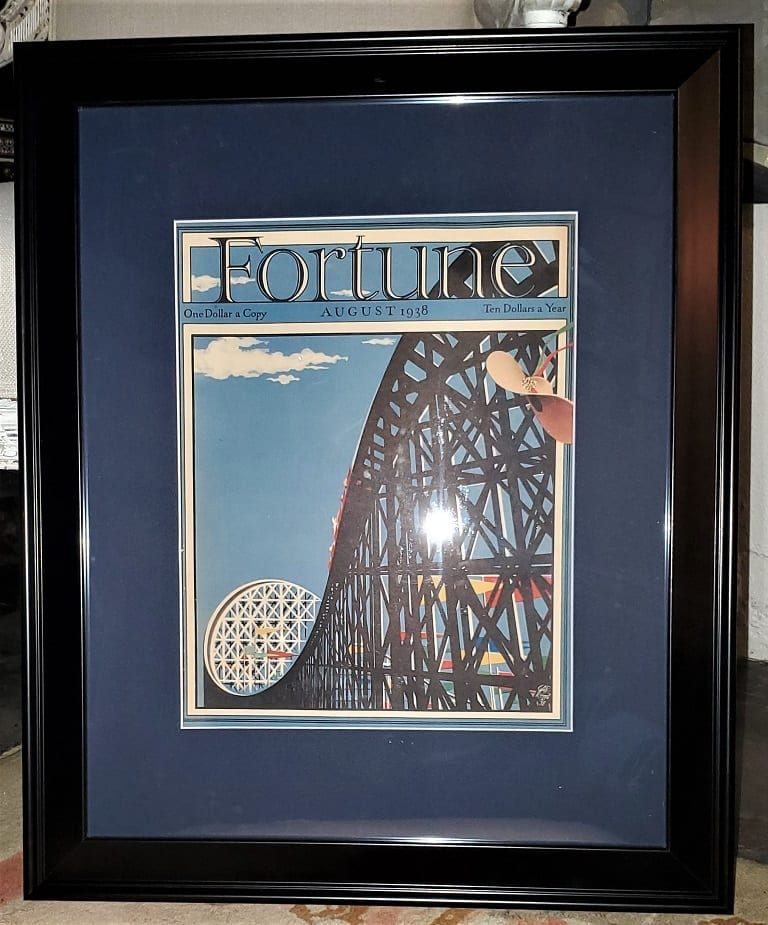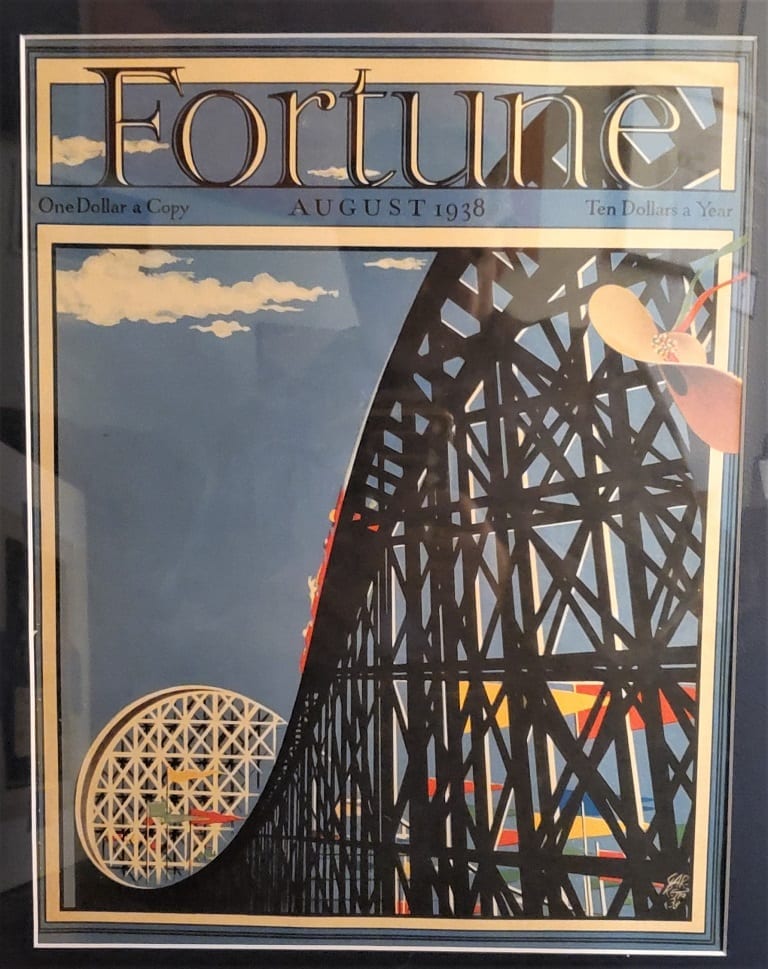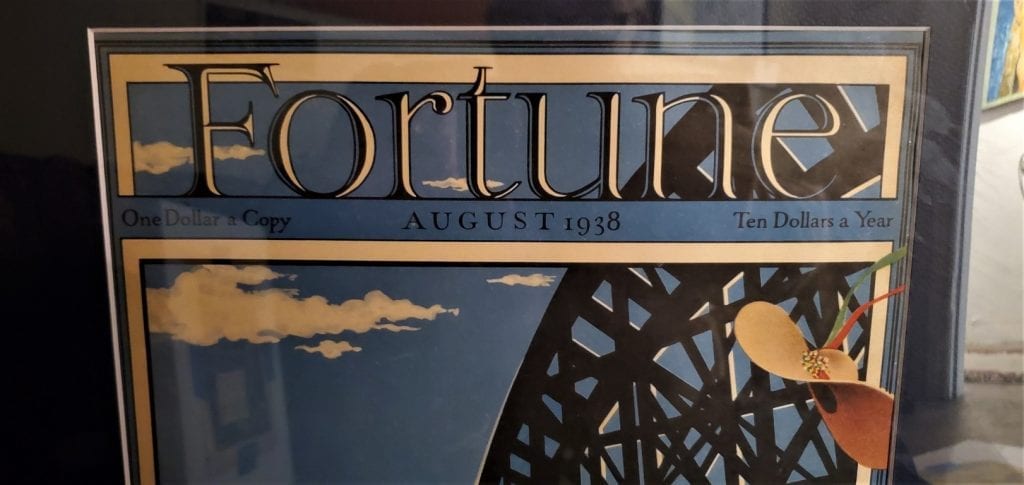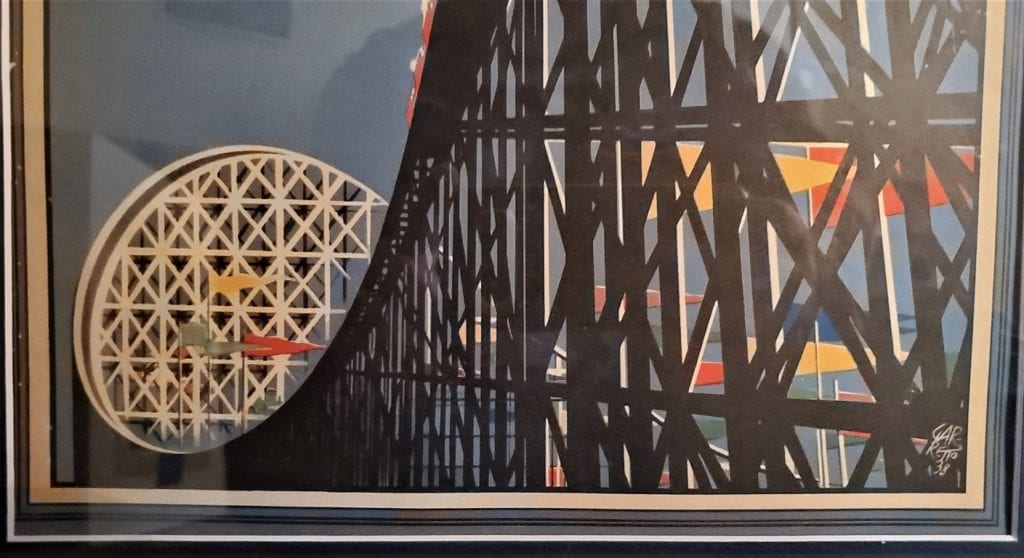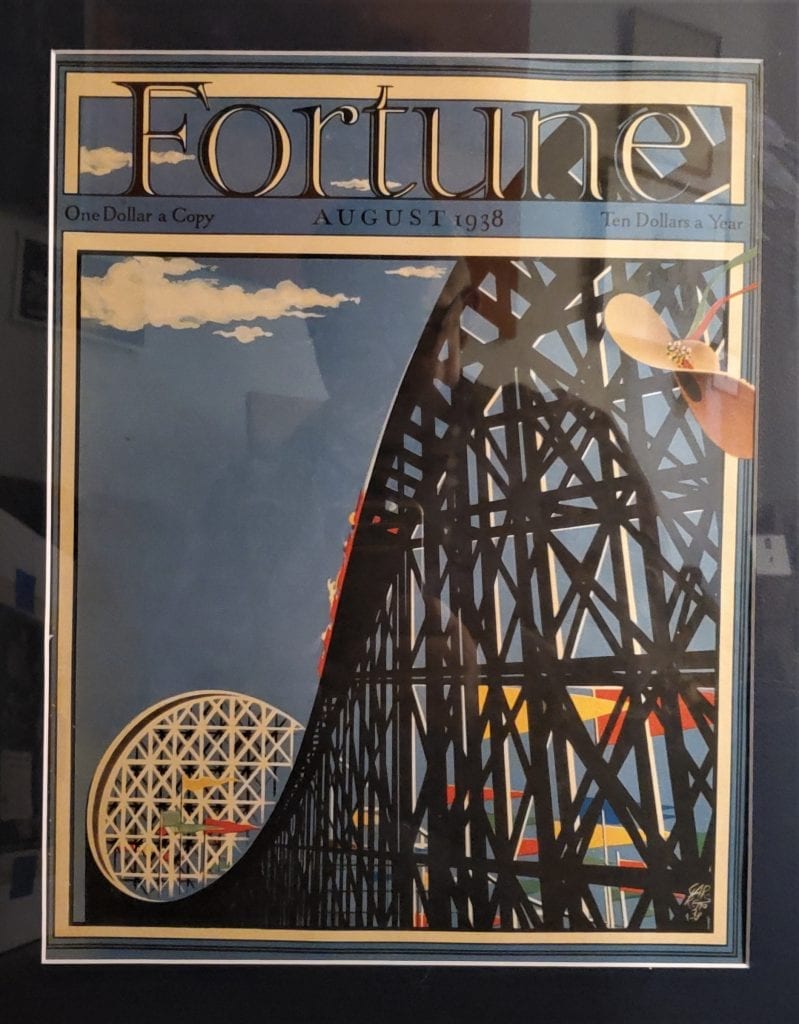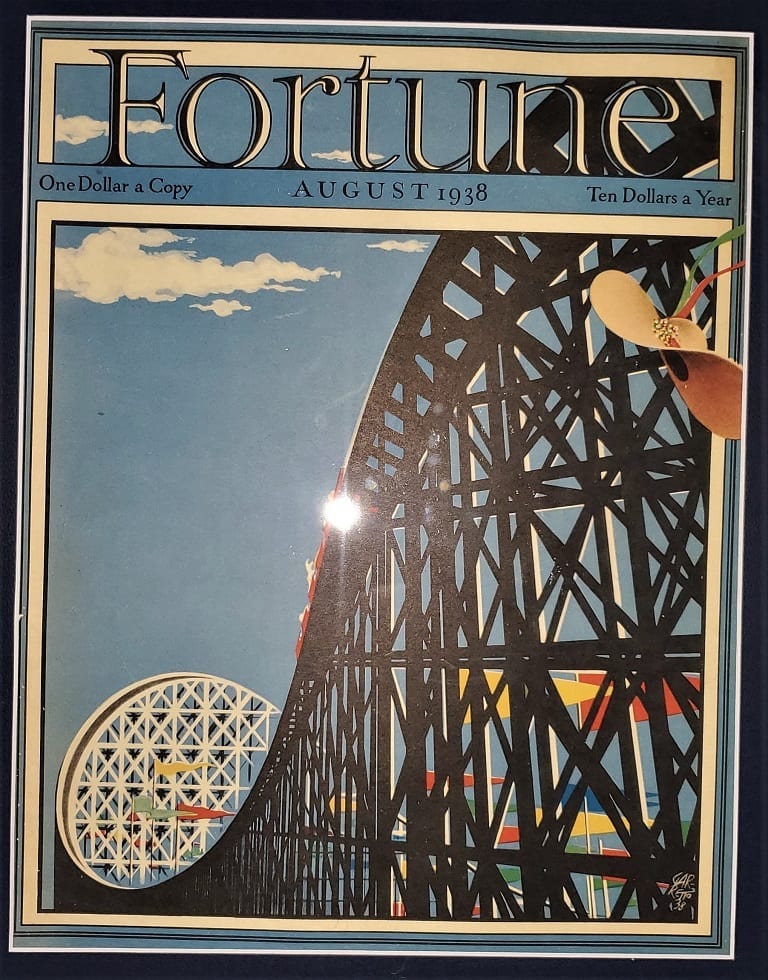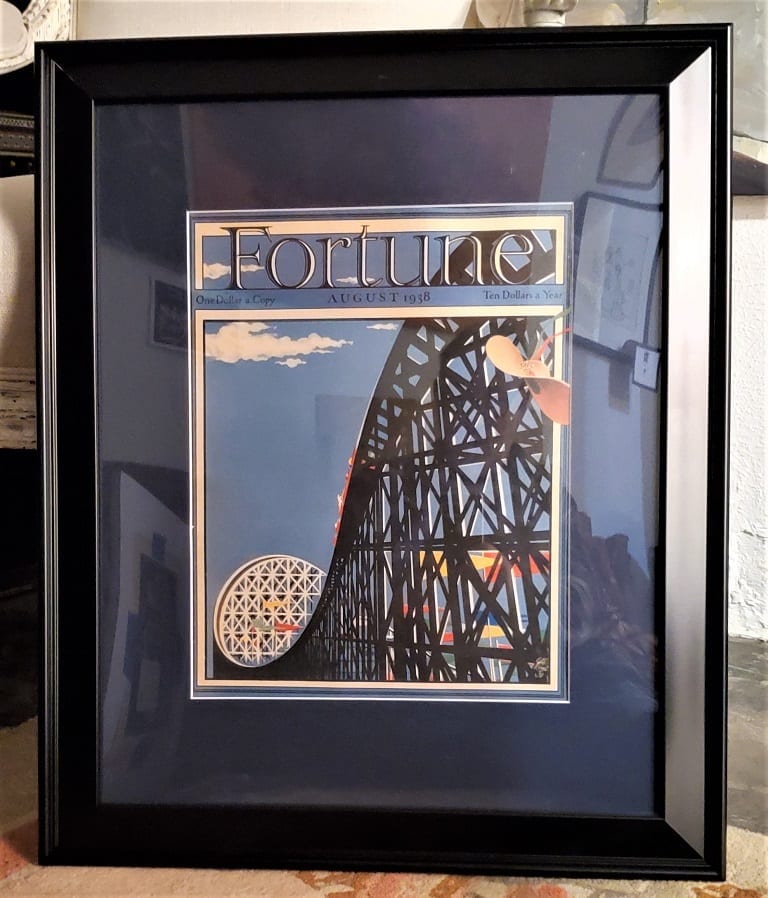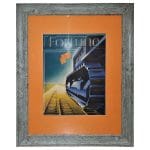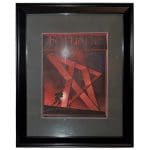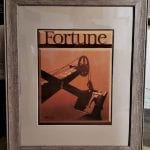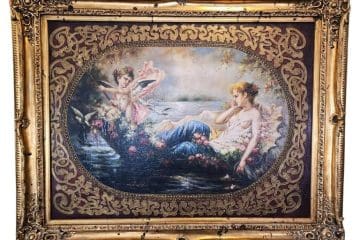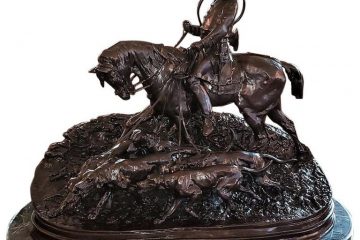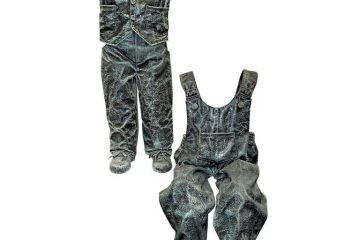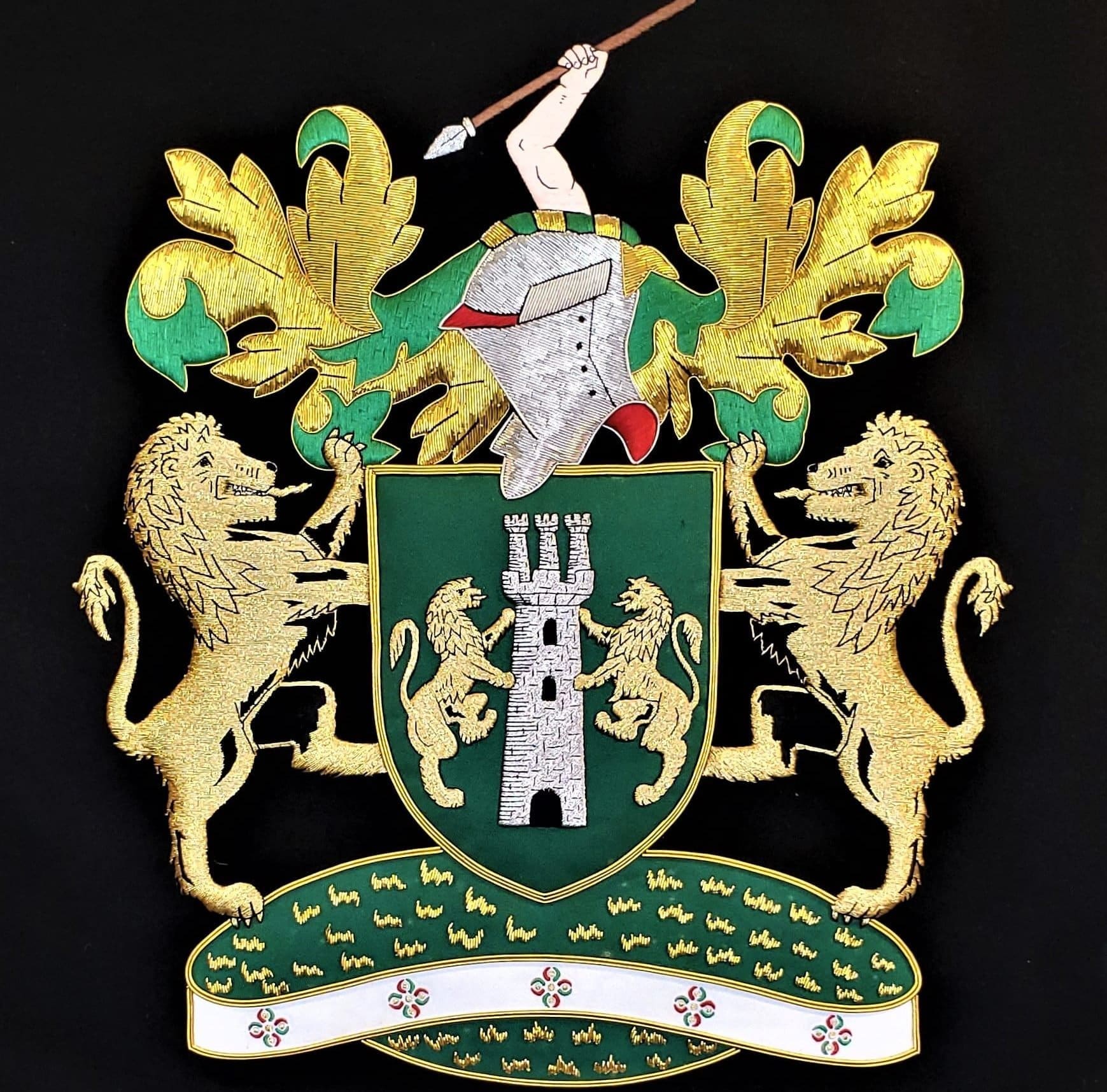Fortune Cover August 1938
PRESENTING a FABULOUS Original Art Deco Fortune Magazine Cover August 1938.
The cover of Fortune Magazine for August 1938, framed and matted.
This is an ORIGINAL COVER, not a re-print or copy. It is the cover of an actual 1938 Fortune Magazine and we can 100% certify it’s authenticity. We have attached a COA on the back of the frame.
The frame is modern. It is in a black poster frame with acid free navy beveled matting. Perspex front. The frame and matting are perfect for the style of the era.
The cover print is an Art Deco depiction of an industrial scene of the Coney Island Roller Coaster in CLASSIC ART DECO STYLE !
The cover is in good condition as can be seen from the photos.
This is one of the more iconic covers of Fortune !
Painted by ‘Paolo Garretto’ as signed on the bottom right.
Paolo Garretto (12 September 1903 – 3 August 1989) was an Italian painter, known as a caricaturist.
Paolo Federico Garretto studied architecture in Rome, but devoted himself, as a student, to graphics. He began working as a caricaturist and advertising painter in London and in 1930 in Paris. Later he moved to Turin, as a correspondent and draughts designer, for the Gazzetta del Popolo,from Paris and New York. In Italy he has collaborated, always as a cartoonist, from the 1930s onwards to Natura, La Lettura, La Rivista illustrata del Popolo d’Italia, Il Becco giallo, Arbiter, Humor,etc. His caricatures attracted the attention of some foreign newspapers and magazines in the 1930s, of which he became a collaborator. These include Vanity Fair, The New Yorker, Fortune, and House & Garden. After moving to the United States, he was forced to return to Italy, following the outbreak of war. The Nazis’ refusal to carry out caricatures of Roosevelt and other allied political leaders cost him deportation and imprisonment in Hungary until 1942. In the post-war period, he worked for epoca magazine.
In 1956 the Italian Advertising Federation awarded him the gold medal.
He died on August 3, 1989 in Monte Carlo, where he had long lived, at Princess Grace Hospital.
With his drawings he illustrated over fifty years of history and entertainment in the world, they also tell the other side of the coin of what the historian Giordano Bruno Guerri called “the greatest Italian caricaturist of the century”.
Paolo Garretto, best known for his political portraits, after the triumphant years of Leonetto Cappiello, at the time when Cassandre operated in France, emerged among the most interesting renewals of graphics, advertising painting, posters and billboards, both for the clear elegance of the composition, and for the promptness with which he understood the characters (see his: Chaplin, Totò, Macario , Mussolini, De Gaule, Hitler, his Negus of 1936, D’Annunzio, Gandhi, Bartali, Onassis, John F. Kennedy, Marilyn Monroe, Marlene Dietrich, André Gide, Margaret Thatcher, the Beatles, etc.), and finally for the application of new or unusual graphic techniques, such as those that use airbrushing, mask samples, typographical screens, various photographic processes, etc.
Link: https://peoplepill.com/people/paolo-garretto
Fortune was founded by The Atlantic Monthly Company co-founder Henry Luce in 1929 as “the Ideal Super-Class Magazine”, a “distinguished and de luxe” publication “vividly portraying, interpreting and recording the Industrial Civilization”. Briton Hadden, Luce’s business partner, was not enthusiastic about the idea – which Luce originally thought to title Power – but Luce went forward with it after Hadden’s sudden death on February 27, 1929.
In late October 1929, the Wall Street Crash of 1929 occurred, marking the onset of the Great Depression. In a memo to the Time Inc. board in November 1929, Luce wrote: “We will not be over-optimistic. We will recognize that this business slump may last as long as an entire year.” The publication made its official debut in February 1930. Its editor was Luce, managing editor Parker Lloyd-Smith, and art director Thomas Maitland Cleland. Single copies of the first issue cost US$1 ($15.3 in 2019). An urban legend says that Cleland mocked up the cover of the first issue with the $1 price because no one had yet decided how much to charge; the magazine was printed before anyone realized it, and when people saw it for sale, they thought that the magazine must really have worthwhile content. In fact, there were 30,000 subscribers who had already signed up to receive that initial 184-page issue. By 1937, the number of subscribers had grown to 460,000, and the magazine had turned half million dollars in annual profit.
At a time when business publications were little more than numbers and statistics printed in black and white, Fortune was an oversized 11″×14″, using creamy heavy paper, and art on a cover printed by a special process. Fortune was also noted for its photography, featuring the work of Margaret Bourke-White, Ansel Adams, and others. Walker Evans served as its photography editor from 1945 to 1965.
During the Great Depression, the magazine developed a reputation for its social conscience, for Walker Evans and Margaret Bourke-White‘s color photographs, and for a team of writers including James Agee, Archibald MacLeish, John Kenneth Galbraith, and Alfred Kazin, hired specifically for their writing abilities. The magazine became an important leg of Luce’s media empire; after the successful launch of Time in 1923 and Fortune in 1930, Luce went on to launch Life in 1936 and Sports Illustrated in 1954.
From its launch in 1930 to 1978, Fortune was published monthly. In January 1978, it began publishing biweekly. In October 2009, citing declining advertising revenue and circulation, Fortune began publishing every three weeks. As of 2018, Fortune is published 14 times a year.
Link: https://en.wikipedia.org/wiki/Fortune_(magazine)
Art Deco, sometimes referred to as Deco, is a style of visual arts, architecture and design that first appeared in France just before World War I. Art Deco influenced the design of buildings, furniture, jewelry, fashion, cars, movie theatres, trains, ocean liners, and everyday objects such as radios and vacuum cleaners. It took its name, short for Arts Décoratifs, from the Exposition internationale des arts décoratifs et industriels modernes (International Exhibition of Modern Decorative and Industrial Arts) held in Paris in 1925. It combined modern styles with fine craftsmanship and rich materials. During its heyday, Art Deco represented luxury, glamour, exuberance, and faith in social and technological progress.
Art Deco was a pastiche of many different styles, sometimes contradictory, united by a desire to be modern. From its outset, Art Deco was influenced by the bold geometric forms of Cubism and the Vienna Secession; the bright colors of Fauvism and of the Ballets Russes; the updated craftsmanship of the furniture of the eras of Louis Philippe I and Louis XVI; and the exotic styles of China and Japan, India, Persia, ancient Egypt and Maya art. It featured rare and expensive materials, such as ebony and ivory, and exquisite craftsmanship. The Chrysler Building and other skyscrapers of New York built during the 1920s and 1930s are monuments of the Art Deco style.
In the 1930s, during the Great Depression, Art Deco became more subdued. New materials arrived, including chrome plating, stainless steel, and plastic. A sleeker form of the style, called Streamline Moderne, appeared in the 1930s; it featured curving forms and smooth, polished surfaces. Art Deco is one of the first truly international styles, but its dominance ended with the beginning of World War II and the rise of the strictly functional and unadorned styles of modern architecture and the International Style of architecture that followed.
Link: https://en.wikipedia.org/wiki/Art_Deco
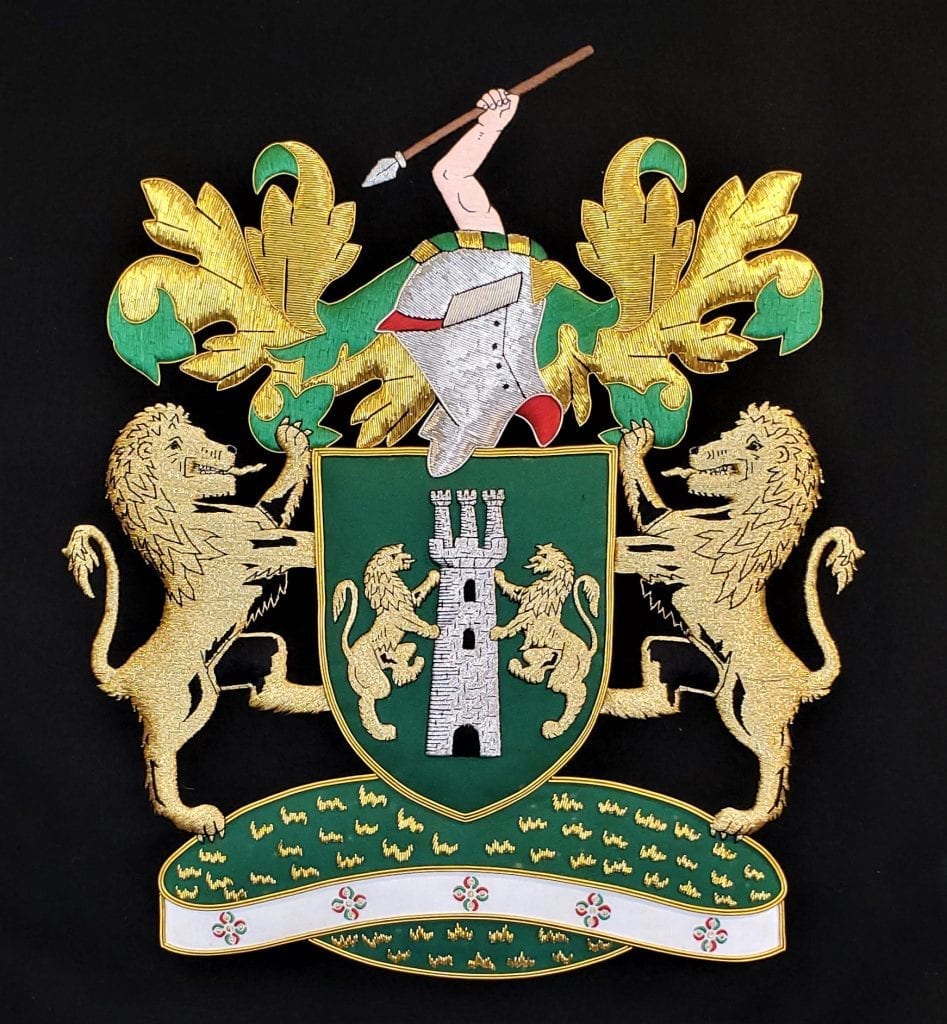

Art Deco Fortune Magazine Cover August 1938.
Provenance: From a Wealthy Dallas Estate.
Condition: Very Good.
Dimensions: In Frame: 23.75″ Tall, 19.75″ Wide and 0.75″ Deep
SALE PRICE NOW: $395
